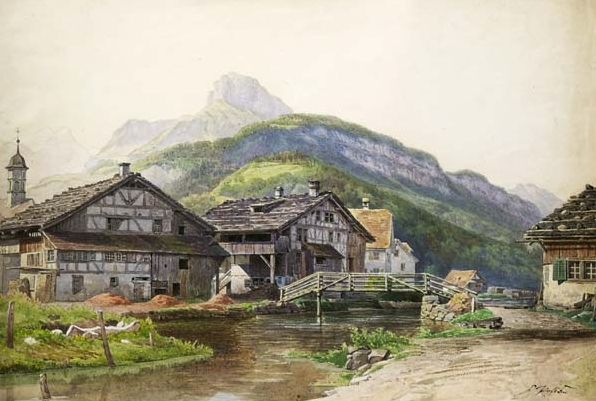Karl Pohlke on:
[Wikipedia]
[Google]
[Amazon]
 Karl Wilhelm Pohlke (28 January 1810 in
Karl Wilhelm Pohlke (28 January 1810 in

(Google Books.)
** 1st volume: ''Darstellung der geraden Linien und ebenen Flächen,so wie der aus ihnen zusammengesetzten Gebilde, vermittelst der verschiedenen Projektionsarten'' ** 2nd volume: ''Darstellung einiger krummer Linien und krummen Flächen''
Pohlke's Theorem -- from Wolfram MathWorld
* Institut für Mathematik und Informatik der Universität Greifswald: ''Mathematik und Kunst''
{{DEFAULTSORT:Pohlke, Karl 1810 births 1876 deaths Engineers from Berlin Artists from Berlin Engineers from the Kingdom of Prussia
 Karl Wilhelm Pohlke (28 January 1810 in
Karl Wilhelm Pohlke (28 January 1810 in Berlin
Berlin ( ; ) is the Capital of Germany, capital and largest city of Germany, by both area and List of cities in Germany by population, population. With 3.7 million inhabitants, it has the List of cities in the European Union by population withi ...
– 27 November 1876 in Berlin) was a German painter who established an important geometric statement, which is fundamental for axonometric projection
Axonometric projection is a type of orthographic projection used for creating a pictorial drawing of an object, where the object is rotated around one or more of its axes to reveal multiple sides.Gary R. Bertoline et al. (2002) ''Technical Graph ...
s. The statement is called Pohlke's theorem Pohlke's theorem is the fundamental theorem of axonometry. It was established 1853 by the German painter and teacher of descriptive geometry Karl Wilhelm Pohlke. The first proof of the theorem was published 1864 by the German mathematician Hermann A ...
.
Life
Karl Wilhelm Pohlke was taught painting byWilhelm Hensel
Wilhelm Hensel (6 July 1794 – 26 November 1861) was a German painter, brother of Luise Hensel, husband to Fanny Mendelssohn, and brother-in-law to Felix Mendelssohn.
Life and career
Wilhelm Hensel was born on 6 July 1794 in the German tow ...
at the Königlich Preussischen Akademie der Künste in Berlin and participated in his first exhibition there in 1832. After finishing his studies he earned his living for some years painting landscapes and teaching perspective drawing privately.
In 1835 Pohlke went to France and improved his abilities at the École des Beaux-Arts
; ) refers to a number of influential art schools in France. The term is associated with the Beaux-Arts architecture, Beaux-Arts style in architecture and city planning that thrived in France and other countries during the late nineteenth centu ...
with Louis Étienne Watelet
Louis Étienne Watelet (25 August 1780, Paris - 21 June 1866, Paris) was a French landscape painter and art teacher.
Biographie
His father was a "Marchand-mercier" (entrepreneur). He is generally credited with being an autodidact. The painte ...
and Léon Cogniet
Léon Cogniet (29 August 1794 – 20 November 1880) was a French history and portrait painter. He is probably best remembered as a teacher, with more than one hundred notable students.
Biography
He was born in Paris. His father was a painter ...
. In 1843 he went to Italy. After 10 years he returned in 1845 to Berlin, where he got 1849 at the Königlichen Bauakademie an appointment as lecturer and in 1860 was promoted to Professor for Descriptive Geometry
Descriptive geometry is the branch of geometry which allows the representation of three-dimensional objects in two dimensions by using a specific set of procedures. The resulting techniques are important for engineering, architecture, design an ...
and Perspective.
Between 1860 and 1876 he published a textbook on descriptive geometry, consisting of two volumes, where he introduced (in the 1st volume) his statement, later called "Pohlke's theorem Pohlke's theorem is the fundamental theorem of axonometry. It was established 1853 by the German painter and teacher of descriptive geometry Karl Wilhelm Pohlke. The first proof of the theorem was published 1864 by the German mathematician Hermann A ...
" on axonometric projection
Axonometric projection is a type of orthographic projection used for creating a pictorial drawing of an object, where the object is rotated around one or more of its axes to reveal multiple sides.Gary R. Bertoline et al. (2002) ''Technical Graph ...
s: "Any three line segments in a plane but not on a line can be considered as the parallel projection of three edges of a cube." This theorem is the mathematical justification of a commonly used drawing method and is a remarkable contribution of an artist to mathematics.
Selected works

Book
* ''Zehn Tafeln zur darstellenden Geometrie.'' Gaertner-Verlag, Berlin 187(Google Books.)
** 1st volume: ''Darstellung der geraden Linien und ebenen Flächen,so wie der aus ihnen zusammengesetzten Gebilde, vermittelst der verschiedenen Projektionsarten'' ** 2nd volume: ''Darstellung einiger krummer Linien und krummen Flächen''
Paintings
* ''Brunnen am Vierwaldstätter See'', * ''Blick auf Glienicke'', atGlienicke Palace
Glienicke Palace () is a historic palace located on the peninsula of Berlin-Wannsee in Germany. It was designed by Karl Friedrich Schinkel around 1825 for Prince Carl of Prussia. Since 1990, Glienicke Palace and the park have been part of the ...
, Berlin
External links
Pohlke's Theorem -- from Wolfram MathWorld
* Institut für Mathematik und Informatik der Universität Greifswald: ''Mathematik und Kunst''
{{DEFAULTSORT:Pohlke, Karl 1810 births 1876 deaths Engineers from Berlin Artists from Berlin Engineers from the Kingdom of Prussia